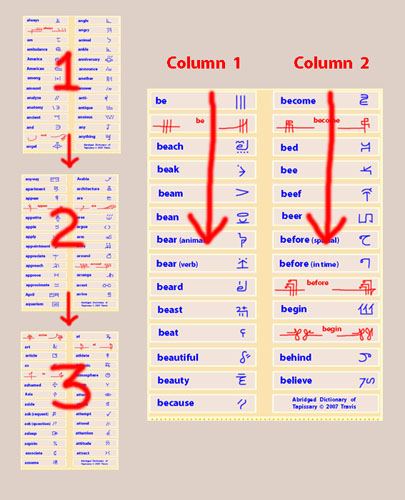

AN ABRIDGED DICTIONARY OF TAPISSARY ©
... under construction (beginning date: Oct 2, 2007)
Progress: I've begun the letter C. Click on a through c of the alphabet bar above.
PLEASE NOTE:
I had never finished this version of the dictionary. A new format is now available on this website, including a grammar section, alphabet, and affixes. Click here to access the 964 word dictionary.
.
.
Tapissary consists of some 8,000 symbols, called çelloglyphs. Because of time constraints, and the space such a dictionary would require on my web site, I have begun a project of condensing this online dictionary to the most common and useful vocabulary. There will be about 2,000 çelloglyphs listed when I've finished. I'm attempting to make the çelloglyphs as legible as possible, which is a bit of a challenge to draw with a mouse. .
,
,
HOW TO USE THE DICTIONARY
Each page will have an alphabet bar at its top, so you can easily click on any letter you want. Then it's a matter of scrolling down the page till you find your word.
There will be additional sections on: affixes, spelling, and basic linear grammar.
Each letter of the alphabet fits onto its own long page made up of a series of vocabulary sheets in alphabetical order. Each vocabulary sheet contains 27 çelloglyphs arranged in 2 columns to be read vertically before moving onto the next sheet.
,

,
.
RED and BLUE ÇELLOGLYPHS
The BLUE çelloglyphs are the base vocabulary. In Tapissary, you read from right to left, the next line down returns from left to right, then the whole process repeats, back and forth snaking down the page. Certain common vocabulary words have a special form when they are written from right to left. In this dictionary, they are written in RED and are only used when reading from right to left. Note that there is an initial form and medial/final form for each of the backward çelloglyphs. The initial form begins a phrase, while the medial/final form is pinned into the middle or at the end of a previous initial form. For example, in the prepositional phrase "for this time", the initial form of FOR would begin the phrase, and string out it's arm long enough to contain the whole phrase. Next, the medial/final çelloglyph for THIS would be pinned somewhere in the middle of FOR's arm. Lastly, the word TIME would come at the end of the arm. By far, most of the vocabulary in this dictionary is coded with blue, and can be read forwards or backwards, but if it has a red form, you should use that for backward writing. There is more about this backward writing system called boustrophedon. Click here for the explanation with examples in written Tapissary.
,
COUNTRIES AND CITIES OF THE WORLD
In general there are not many geographical names that have a çelloglyph character in Tapissary. Most are written with the alphabet. Exceptions are those places I have used often in translations.
.
COPYRIGHT
Please note that Tapissary is copyrighted. I have provided the work here for your casual use and enjoyment. This abridged version of the dictionary is free and you may download a copy for yourself or a friend. Copies may not be offered for sale. Permission must be arranged with Steven Travis for any intended professional use of Tapissary. The current contact email is: info@tapissary dot com.